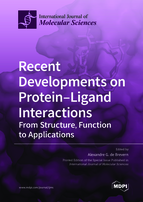Recent Developments on Protein–Ligand Interactions: From Structure, Function to Applications
A special issue of International Journal of Molecular Sciences (ISSN 1422-0067). This special issue belongs to the section "Molecular Informatics".
Deadline for manuscript submissions: closed (31 January 2020) | Viewed by 58826
Special Issue Editor
Interests: structural bioinformatics; bioinformatics; next-generation sequence; drug design; deep learning
Special Issues, Collections and Topics in MDPI journals
Special Issue Information
Dear Colleagues,
Protein–ligand interactions play a fundamental role in most major biological functions, but also in drug discovery. With the increasing structural information of proteins and protein–ligand complexes, molecular modelling, molecular dynamics, and chemoinformatics approaches are often required for the efficient analysis of a large number of such complexes and to provide insights. Similarly, numerous computational approaches have been developed to characterize and use the knowledge of such interactions, which can lead to drug candidates. For instance, one main application is to identify tractable chemical startpoints that non-covalently modulate the activity of a biological molecule. This new information brings questions that affect chemistry, biology, and even poses specific computer problems. Papers related to any aspect of protein–ligand analysis and/or prediction using computational approaches, as well as new developments dedicated to these tasks, will be considered for this Special Issue.
Prof. Dr. Alexandre G. de Brevern
Guest Editor
Manuscript Submission Information
Manuscripts should be submitted online at www.mdpi.com by registering and logging in to this website. Once you are registered, click here to go to the submission form. Manuscripts can be submitted until the deadline. All submissions that pass pre-check are peer-reviewed. Accepted papers will be published continuously in the journal (as soon as accepted) and will be listed together on the special issue website. Research articles, review articles as well as short communications are invited. For planned papers, a title and short abstract (about 100 words) can be sent to the Editorial Office for announcement on this website.
Submitted manuscripts should not have been published previously, nor be under consideration for publication elsewhere (except conference proceedings papers). All manuscripts are thoroughly refereed through a single-blind peer-review process. A guide for authors and other relevant information for submission of manuscripts is available on the Instructions for Authors page. International Journal of Molecular Sciences is an international peer-reviewed open access semimonthly journal published by MDPI.
Please visit the Instructions for Authors page before submitting a manuscript. There is an Article Processing Charge (APC) for publication in this open access journal. For details about the APC please see here. Submitted papers should be well formatted and use good English. Authors may use MDPI's English editing service prior to publication or during author revisions.
Keywords
- protein–ligand analysis
- protein–ligand interaction fingerprints
- structure protein–ligand interaction relationships
- structure–activity relationships
- molecular modeling
- molecular dynamics
- chemogenomics
- chemical biology
- drug discovery and design
- fragment-based lead discovery
- 2D interaction maps
- 3D activity
- hot spots
- pharmacophore







